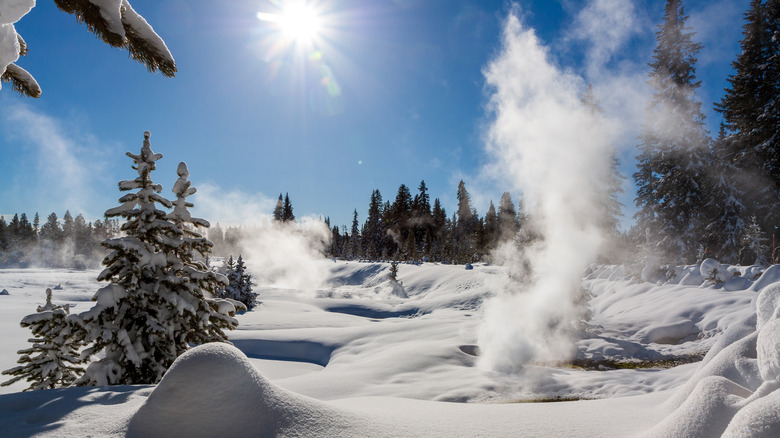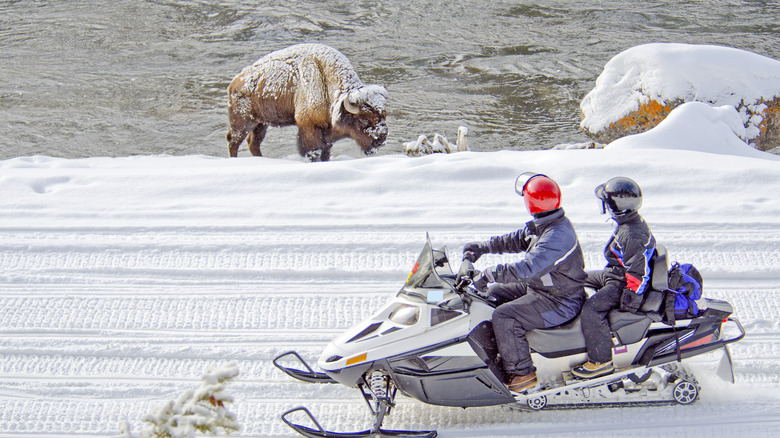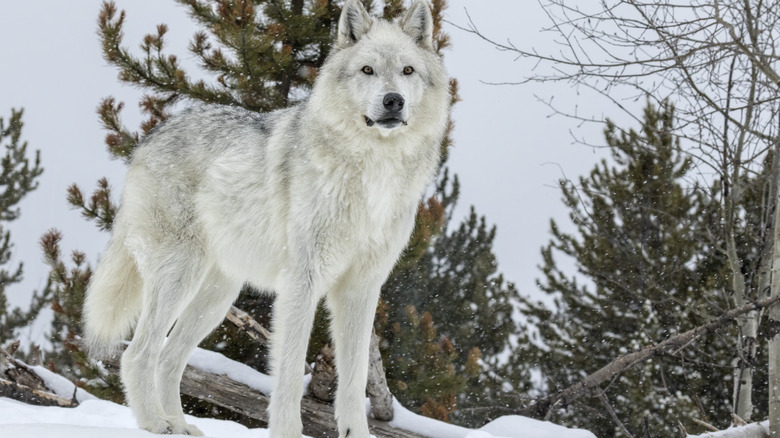The Best Time Of Year To Visit Yellowstone National Park
During the winter, Yellowstone National Park is cold, windy, desolate, and astonishingly beautiful. The park transforms from a popular tourist sensation back into Yellowstone's natural splendor, existing for its own sake. From November to March, says the National Park Service, Yellowstone National Park welcomes a very small percentage of its annual guests, so when you visit in winter, the park just seems larger, wilder, and a bit more majestic.
If you've never been to Yellowstone, let's not split hairs — go whenever, however. It really is one of the world's most impressive natural wonders. But if you've only visited when it's warm, explore the park again in a new way. Go in winter.
The summer crowds aren't chasing buffalo herds with iPhones, and the stillness of frosted evergreens replaces the impatient car honks of peak season. The park's iconic geysers billow into the park's wintry fog, while snowy meadows offer better-than-usual views of distant wildlife. Of course, it's super-subjective judging the best season to visit Yellowstone National Park (they're all pretty great), but winter is just ... different.
Winter in Yellowstone is an adventurer's wonderland
For adventure travelers, a snowy Yellowstone National Park provides unique opportunities for those who prefer the road literally less traveled. Starting in the first week of November, cars are not allowed in the park, except for one route through the North Entrance, according to Travel Wyoming. This limited stretch of road only takes visitors to Mammoth Hot Springs and the few lodging options inside Yellowstone.
As the winter and snow settle in, the other closed roads and entrances open to over-snow travel. In mid-December, the park's paved roads turn into winding, snow-covered trails, and you can explore the park by snowshoeing, cross-country skiing, snowmobile, and snowcoach.
Plenty of experienced outfitters offer guided snowmobile and snowcoach tours, as well as rent gear for those looking to ski or snowshoe around the park. If you're a bit hesitant to explore the park alone in winter (it can be intimidating), guides are available to lead cross-country skiing and snowshoeing excursions through Yellowstone's backcountry.
Yellowstone's winter wildlife is unmatched
The Yellowstone landscapes are majestic, but the wildlife that resides in these landscapes is closer to mystical. The snow-covered bisons in their winter coats and full beards beckon visions of wild America's past, before the West's discovery of the New World and pioneering expansion.
Covering almost 3,500 square miles, Yellowstone National Park is massive, and while it doesn't feel small during peak season, the park feels infinite in the winter. The scale of distant mountains and expansive forest, all blanketed anew with snowdrift, seems to reach into an unspoiled time. In this past, the interconnection of the park's ecology played out without interfering modernity.
Barring maybe the wolves, the animals are not shy in Yellowstone. This is probably due to commonly interacting, hearing, and seeing people. But in the winter, perhaps because of the park's silence and stillness, the wildlife seems to revert back into a more natural state. The animals aren't so desensitized to the car mufflers, full campgrounds, and bustling photo-op attractions. When visiting in winter, you'll still have the opportunity to see plenty of wildlife, but the opportunities seem less invasive to the park's natural order. For example, the park still offers wildlife tours in winter, but the groups are typically a lot smaller, so the park's wildlife seems more apt to share its secrets.
Explore wants to acknowledge that Yellowstone National Park is the traditional territory of 27 associated Indian tribes, including the Nez Perce, Sioux, Blackfeet, and Crow.


